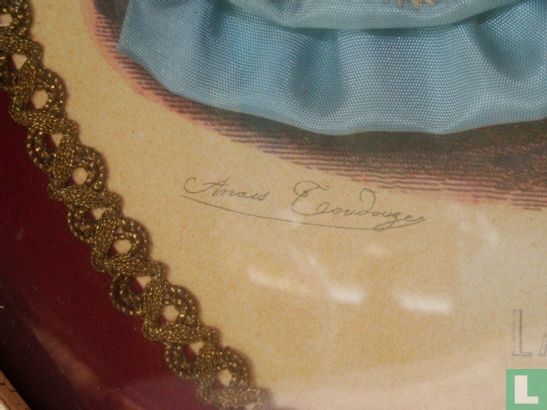Antique wooden carved and gilded oval frame with image of "La Mode Illustrée"
from Bureaux du Journal, 56 rue Jacob Paris.
Year 1873 - "Toilettes de Mme Fladry, 43 rue Richer
Signed "Anais Toudouze"
Adele-Anais Toudouze (Paris, 1822-1899) was one of the most important artists of La Mode. She belonged to a very talented family of artists and engravers. Other family members who produced fashion records and fine art included her mother, Alexandre-Marie Colin (1798-1873) and her daughter, Isabelle Toudouze (1872-1925). In 1845 Adele-Anais married the painter and architect, Gabriel-Auguste Toudouze.
In the mid-Victorian era, two factors directly contributed to the development of the original fashion engraving. The sewing machine was widely used during the last 1850s and by the 1860s paper patterns had been introduced before. High fashion was thus now available for the first time to most women. Second, a new and rapidly growing economic strength was felt and the publishing industry began to cater directly to both upper and middle-class women. The fashion market underwent tremendous expansion with such publishers as Peterson's and Godey's, in America, and the English's Domestic Magazine, in Great Britain, printing a large number of fashion engravings and patterns. Paris, however, was the center of everything and La Mode Illustree (The Illustrated Fashion) was the undisputed leader of fashion engraving during this period.
From 1860-1872 La Mode created some of the finest fashion records of the era. The engravings were larger, more detailed and much more artistically hand-colored than any of its competitors in England, France or America. By 1872, however, the high cost of publishing these original works of art - such as this example - was also prohibitively expensive, and La Mode was forced to cede the area to its cheaper rivals.
For years these original engravings have been eagerly sought after by collectors. The appeal of these works, in fact, is so strong that photomechanical reproductions have been since the early 1920s. One can easily determine these reproductions by the poor quality of the paper and by the general dullness of the image and colors.
This is a hand-colored depiction of 17th century fashion
The drawing is "dressed" with the silk (or satin) fabrics and lace as shown in the picture
The list is intact
This text has been translated automatically from Dutch
Click here for the original text
Antieke houten gesculpteerde en vergulde ovalen lijst met afbeelding van "La Mode Illustrée"
uit Bureaux du Journal, 56 rue Jacob Paris.
Jaar 1873 - "Toilettes de Mme Fladry, 43 rue Richer
Getekend "Anais Toudouze"
Adele-Anais Toudouze (Parijs, 1822-1899) was één van de belangrijkste kunstenaars van La Mode. Ze behoorde tot een zeer getalenteerde familie van kunstenaars en graveurs. Andere familieleden die mode platen geproduceerd en beeldende kunst opgenomen haar moeder, Alexandre-Marie Colin (1798-1873) en haar dochter, Isabelle Toudouze (1872-1925). In 1845 trouwde Adele-Anais de schilder en architect, Gabriel-Auguste Toudouze.
In het midden van de Victoriaanse tijdperk direct twee factoren hebben bijgedragen aan de ontwikkeling van de oorspronkelijke fashion graveren. De naaimachine werd veel gebruikt tijdens de laatste 1850 en door de jaren 1860 papier patronen was ingevoerd voor. High fashion was nu dus beschikbaar voor de eerste keer voor de meeste vrouwen. Ten tweede, een nieuwe en snel groeiende economische kracht was voelbaar en de uitgeverswereld begon direct tegemoet te komen aan zowel de bovenste en vrouwen uit de middenklasse. De mode-markt onderging een enorme expansie met zulke uitgevers als Peterson's en Godey's, in Amerika, en de Engelse's Domestic Magazine, in Groot-Brittannië, het afdrukken van een groot aantal mode-gravures en patronen. Parijs, was echter het centrum van alles en La Mode Illustree (The Illustrated Fashion) was de onbetwiste leider van de mode-graveren in deze periode.
Van 1860-1872 La Mode creëerde enkele van de mooiste mode-platen van het tijdperk. De gravures waren groter, gedetailleerder en veel meer artistiek handgekleurde dan elk van haar concurrenten in Engeland, Frankrijk of Amerika. Door 1872, echter de hoge kosten van het publiceren van deze originele kunstwerken - zoals dit voorbeeld --were ook onbetaalbaar, en La Mode werd gedwongen om het gebied af te staan aan zijn goedkopere rivalen.
Jarenlang deze originele gravures zijn gretig gezocht door verzamelaars. De aantrekkingskracht van deze werken, in feite, is zo sterk dat fotomechanische reproducties zijn sinds de vroege jaren 1920 geweest. Men kan gemakkelijk bepalen op deze reproducties wordt door de slechte kwaliteit van het papier en door de algemene saaiheid van het beeld en de kleuren.
Dit is een met de hand ingekleurde afbeelding van de mode uit de 17e eeuw
De tekening is "aangekleed" met de zijden (of satijnen) stoffen en kantwerk volgens de afbeelding
De lijst is ongeschonden











